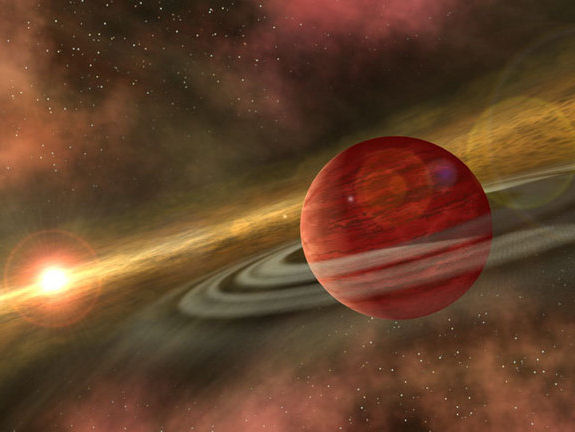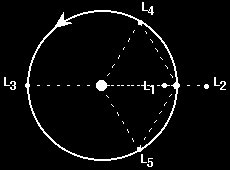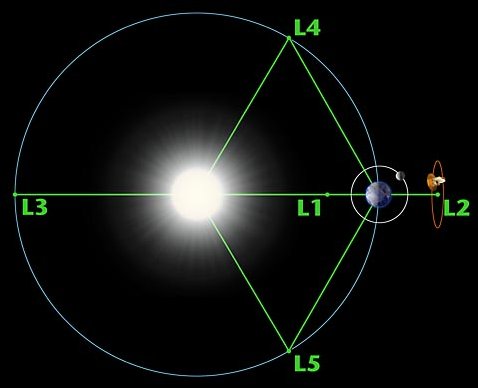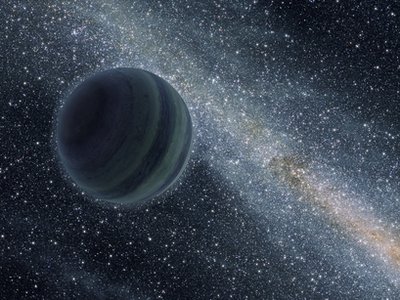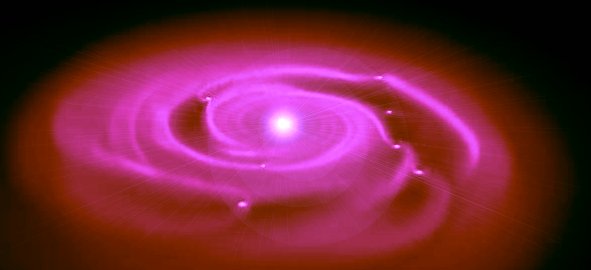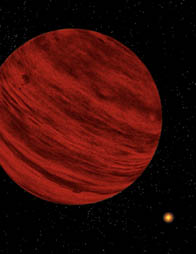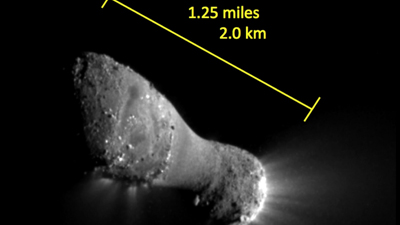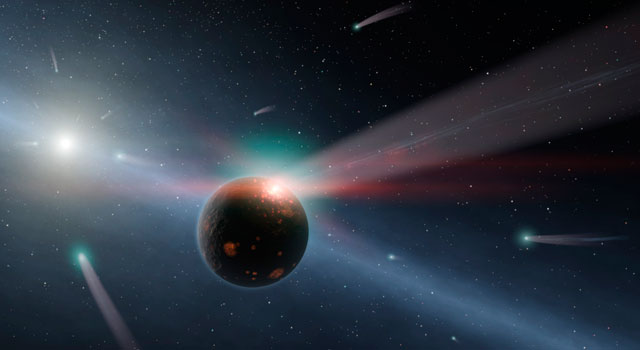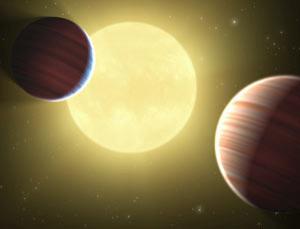At last, a celestial object
falling into the category of a 'Dark Star' has been
discovered. It's not orbiting our own Sun, regrettably, but
it has various properties that are similar to the object I
suggest is our Sun's binary companion.
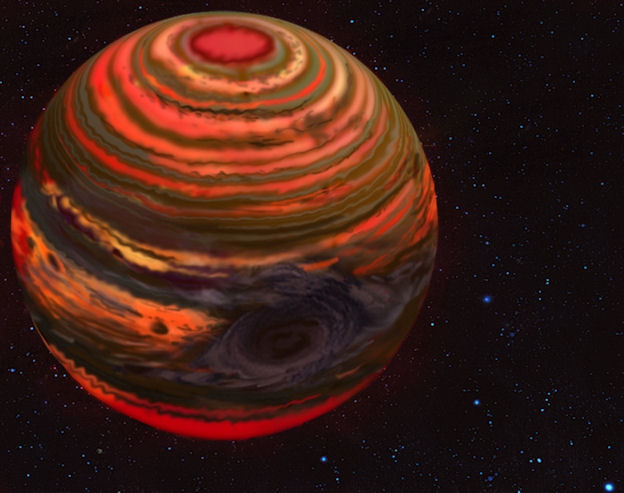
The new sub-brown dwarf lies
some 63 light years away, and is called WD 0806-661 B. It
has 7 Jupiter masses, which pitches it below the Brown Dwarf
category, and into the 'sub-brown dwarf' set of hitherto
undiscovered objects (that lie between gas giants and dwarf
stars). It is this category that I term the Dark Stars.
I'm very pleased that such an object has been identified.
Its outer temperature is about 30 Celsius, so it's likely to
be pretty dark indeed. I've always imagined these objects to
be rather similar to the embers of a dying fire, where
reddish light flickers intermittently within the darkened
ashes. That may be the case here, because this Dark Star is
quite a lot warmer than Jupiter.
But it's the object's orbital characteristics that provides
even more substance to support the Dark Star theory. WD
0806-661 B orbits around its parent star, WD 0806-661 A, at
the remarkable distance of 2500 Astronomical Units. If our
own companion object were to share a similar orbit, then it
would be located at the inner edge of the inner Oort Cloud.
This, I suspect, is about right for our own Dark Star. WD
0806-661 B thus creates a wonderful precedent for such a
companion showing how such a scenario is patently possible.
Another aspect to this discovery is that the outer layers of
this sub-brown dwarf's atmosphere are able to sustain liquid
water. The atmospheric constituents are likely to be very
different from the Earth's, but one can quite imagine rain
clouds in the upper atmosphere of this gas giant. Is it
possible that life could exist in this environment? As a gas
giant, there is no terrestrial surface upon which life could
emerge. But might there not be exotic life-forms capable of
living solely in the clouds? This is a tantalizing
consideration.
Andy Lloyd, 15th March 2011
Reference:
1) New Scientist "Newly found
brown dwarf is ultra-cool", 12 March 2011, with thanks to
David
newscientist.com article
BD is "Cup of Tea" Temperature
Cool brown
dwarfs are starting to crop up all over the place, thanks to
a new generation of high-powered telescopes. The
theoretical belief that these object are as least as common
as stars is being confirmed. This leads us towards the
exciting possibility that brown dwarfs, or sub-brown dwarfs,
may be discovered at a closer distance than Proxima
Centauri, our nearest 'regular' star. Furthermore, it
also opens up the possibility that one or more sub-brown
dwarfs might be found orbiting the Sun at a remote location.
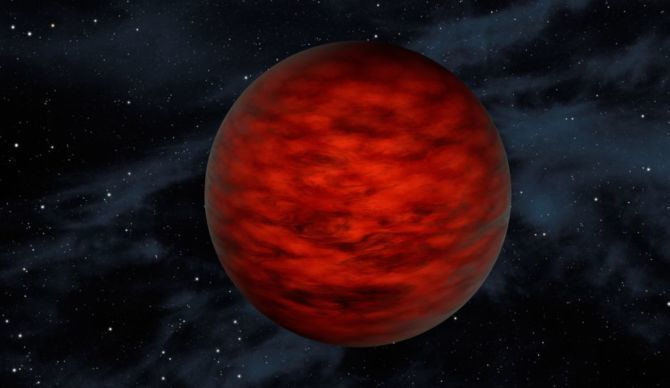
Image Credit: NASA
The latest
discovery is the actual imaging of a brown dwarf
(CFBDSIR J1458 + 1013B) whose upper atmospheric temperature
is around the boiling point of water. Located 75 light
years away, it orbits another brown dwarf, meaning that the
light of the parent star is not bright enough to obscure it
completely. This new object, which falls into the new 'Y'
spectral class of sub-brown dwarfs, has a bluish tinge to
it, perhaps like our outer gas giant Neptune. But its mass
exceeds that of Jupiter, and its temperature is evidently
much higher than a standard gas giant. Expect more
discoveries like this in the coming months.
Andy, 25th
March 2011
Reference: Julian Gavaghan
"The coolest star in the sky! Newly discovered 'Brown Dwarf'
has same temperature as a cup of tea" 25 March 2011, with thanks to Mart
dailymail.co.uk article
Photosynthesis near a Dark Star
As many of my readers will
know, I've looked closely down the years at how a habitable environment might
exist on a terrestrial-sized moon in close orbit around a failed sub-brown dwarf
star. Where it is relatively straightforward to show how water would exist
on such a world, a more tricky question has arisen around how vegetation would
grow in such an environment. The so-called extremeophiles found on Earth are
testament to the sheer tenacity of life in harsh environments. But if
we're talking about actual vegetation growing on the surface of the terrestrial
world orbiting a Dark Star, then greater complexity is involved.
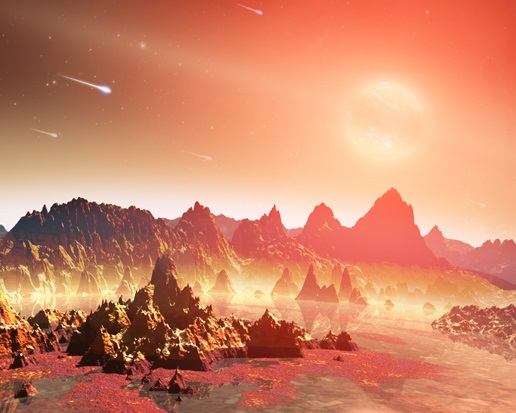
Image credit: NASA/JPL-Caltech
This has been presented as a
sticking point for my theory. Vegetation on Earth needs UV/blue light
radiation from the Sun to thrive, through photosynthesis. But could a Dark
Star provide the kind of energy required to sustain plant life? And if
not, then how could animal life be sustained on a world devoid of vegetation?
Well, recent research offers us a glimpse of how this might work:
"The
temperature of a star determines its colour and, hence, the colour of light used
for photosynthesis. Depending on the colours of their star-light, plants would
evolve very differently," said [Jack] O'Malley-James ... [who] is working on a
PhD to assess the potential for photosynthetic life in multi-star systems with
different combinations of Sun-like stars and red dwarfs.
""Our simulations
suggest that planets in multi-star systems may host exotic forms of the more
familiar plants we see on Earth. Plants with dim red dwarf suns for example, may
appear black to our eyes, absorbing across the entire visible wavelength
range in order to use as much of the available light as possible. They may
also be able to use infrared or ultraviolet radiation to drive photosynthesis."
This hypothesis
is untested, of course. But I'm buoyed up that extra-terrestrial plants
might find a way despite a lack of ultra-violet/blue light radiation from a Dark
Star. By utilising more photosynthetic pigments, plants on the moon of a
Dark Star would be black, and bathed in purplish red light from their nearby
cold 'sun'.
Andy Lloyd,
24th April 2011
Reference:
Royal Astronomical Society "NAM
14: Could black trees blossom in a world with two suns?"
20 April 2011,
with thanks to Tom
sciencedaily.com article
Hot Jupiters with
Reverse Swing
Extra-solar planets are
plentiful, and often bizarre. Here's a very odd example. It's in the
Scorpius constellation, about 1000 light years away, and is called WASP-17.
Unusually, its orbit proceeds backwards, and is tilted at a spectacular 150
degrees, whilst lying extremely close to its own sun (1). It is twice the
size of Jupiter, with half the mass, so is too small to be classified even as a
sub-brown dwarf. Nevertheless, it shows some interesting Dark Star
characteristics.
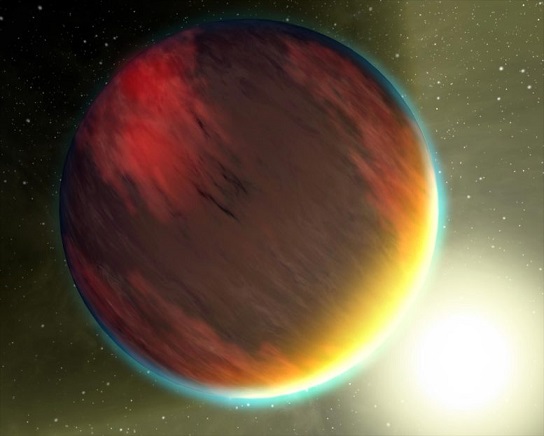
Image Credit: NASA/JPL-Caltech
Astrophysicists now think the backwards-spin may be
attributable to a gravitational coupling between two planets:
"In some
solar systems, the sun spins one way while a giant gassy planet, known as a hot
Jupiter, orbits in the opposite direction. Scientists, reporting in the
journal Nature, attribute the effect to gravitational coupling between two
planets as they near each other, which leads to the planet nearest its sun, over
time, having its orbit flipped as it is hauled much closer to the star."
(2)
The whole scenario of
oppositely-spinning planets is a bizarre one. It defies conventional
wisdom. To explain such blatant anomalies, scientists have to reach for
some unconventional concepts. Like highly remarkable migrations of gas
giant planets. The concept of such immense migration is outlined here:
"'How can
one be spinning one way and the other orbiting exactly the other way? It's
crazy. It so obviously violates our most basic picture of planet and star
formation.' Astronomers have long theorised that big gas planets form further
away from their stars, while Earth-like rocks are born closer in But just
because a Jupiter-like planet forms in the outer reaches of a solar system
doesn't mean it stays there,
[Frederic Rasio of Northwestern University] and his colleagues reported.
When planetary systems contain more than one planet, in addition to a star, each
planet has its own gravitational force, causing the planets to interact and
eventually pulling the gas giants close to the star and even reversing its
orbit, the scientists found. This process is known as gravitational
perturbation, or an exchange of angular momentum."
(2)
In these crucial lines I see
mechanisms for how a massive Planet X body could find itself in a wide
elliptical orbit around the Sun. The Dark Star may have formed initially
nearer to the Sun, causing cataclysms early in the solar system's history.
It was those fateful interactions that 'exchanged angular momentum' through
'gravitational perturbation' and flung the Dark Star out into its current wider
orbit. One does not need to imagine a captured planet at all - a
key critique of Sitchin's 12th Planet Theory down the years, especially by the
late Tom van Flandern.
Andy Lloyd, 13th May 2011
References:
1) Paul Gilster "WASP-17b: Unusual World
Bloated by Tides" 13 August 2009
centauri-dreams.org article
2) Daily Mail "Reason why giant planets in other solar systems orbit the 'wrong'
way finally explained" 12 May 2011, with thanks to Mart
dailymail.co.uk article
Io and the Dark Star
Jupiter's closest Galilean
moon, Io, is a furnace of volcanic activity across its entire surface - making
it the most active of all the worlds in the solar system. This is
attributable to its proximity to Jupiter, whose immense gravitational power and
magnetic field play havoc with the tiny world's interior. This is an
important consideration for the Dark Star Theory, because it shows how a similar
scenario could play out in the much colder outer solar system. In other
words, a Earth-sized moon orbiting a sub-brown dwarf in the outer solar system
could be significantly warmed internally by the same mechanism.
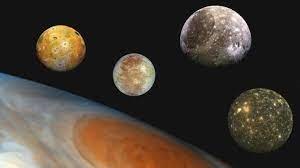
Recent work by scientists has
shown that Io has a global magma ocean about 30 to 50 kilometres (20 to 30
miles) beneath its crust. It's a remarkable find in a world so small:
before this, magma oceans have been known to exist only on Earth.
"Krishan Khurana, lead author of the study and former co-investigator on
Galileo's magnetometer team at UCLA, says "It turns out Io was continually
giving off a 'sounding signal' in Jupiter's rotating magnetic field that matched
what would be expected from molten or partially molten rocks deep beneath the
surface.""
(1)
Over ten years since I first presented my
hypothesis, I still get emails from other Sitchinites who argue that a
terrestrial world in the outer solar system could be internally warmed,
independently of a Dark Star. In his final book, the late Zecharia
Sitchin defended his stance on this issue, believing that a sufficiently robust
atmosphere would hold in the heat generated by Nibiru's core (the heat is
presumably generated by radioactivity in his scenario) (2). Regrettably,
this seems almost impossible (I say 'almost' because one can never
say "never" in science. It just seems hopelessly unlikely).
Instead,
the gases of a fledgling Nibiruan atmosphere would simply precipitate out in the
intense cold of the outer solar system, to form a thick layer of ice across the
planet's surface. Without an external source of gravitational, magnetic
and infra-red energy, Nibiru would be dead in the water. Only a
neighbouring Dark Star offers a tangible solution to this issue: a
habitable surface on a warm terrestrial world orbiting a sub-brown dwarf.
2022 Update: The possibility that
Io has a magma ocean continues to be debated by scientists and remains an open
question until more data can be collected by future missions:
"The idea
of a magma ocean inside Io generally lost favor in subsequent studies, until
Khurana et al. [2011] presented evidence from Galileo mission data of an
induced magnetic signature from Io. Induced signatures from Europa, Ganymede,
and Callisto (another of Jupiter’s moons that with Io, Europa, and Ganymede,
make up what are known as the Galilean satellites) had previously been
interpreted as being caused by salty oceans, which are electrically
conducting—and molten silicates are also electrically conducting. Considerable
debate persists about whether Io has a magma ocean." (3)
Andy Lloyd, 13th May 2011
